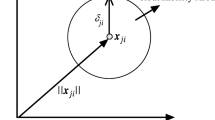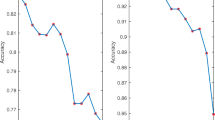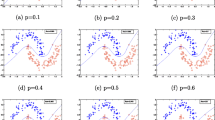Abstract
The least squares twin support vector machine (LSTSVM) generates two non-parallel hyperplanes by directly solving a pair of linear equations as opposed to solving two quadratic programming problems (QPPs) in the conventional twin support vector machine (TSVM), which makes learning speed of LSTSVM faster than that of the TSVM. However, LSTSVM fails to discover underlying similarity information within samples which may be important for classification performance. To address the above problem, we apply the similarity information of samples into LSTSVM to build a novel non-parallel plane classifier, called K-nearest neighbor based least squares twin support vector machine (KNN-LSTSVM). The proposed method not only retains the superior advantage of LSTSVM which is simple and fast algorithm but also incorporates the inter-class and intra-class graphs into the model to improve classification accuracy and generalization ability. The experimental results on several synthetic as well as benchmark datasets demonstrate the efficiency of our proposed method. Finally, we further went on to investigate the effectiveness of our classifier for human action recognition application.








Similar content being viewed by others
Notes
The Cython is a superset of the Python programming language and generates efficient C code. More info at http://cython.org/
References
Aggarwal JK, Ryoo MS (2011) Human activity analysis: a review. ACM Comput Surv (CSUR) 43(3):16
Behnel S, Bradshaw R, Citro C, Dalcin L, Seljebotn DS, Smith K (2011) Cython: the best of both worlds. Comput Sci Eng 13(2):31–39
Bishop CM (2006) Pattern recognition and machine learning. Springer
Cai D, He X, Zhou K, Han J, Bao H (2007) Locality sensitive discriminant analysis. In: IJCAI, vol 2007, pp 1713–1726
Cheng G, Wan Y, Saudagar AN, Namuduri K, Buckles BP (2015) Advances in human action recognition: a survey. arXiv:150105964
Cortes C, Vapnik V (1995) Support-vector networks. Mach Learn 20(3):273–297
Demšar J (2006) Statistical comparisons of classifiers over multiple data sets. J Mach Learn Res 7:1–30
Ding S, Yu J, Qi B, Huang H (2014) An overview on twin support vector machines. Artif Intell Rev 42(2):245–252
Ding S, Zhang N, Zhang X, Wu F (2017) Twin support vector machine: theory, algorithm and applications. Neural Comput and Applic 28(11):3119–3130
Golub GH, Van Loan CF (2012) Matrix computations, vol 3. JHU Press
Ho T, Kleinberg E (1996) Checkerboard dataset
Jayadeva KR, Chandra S (2007) Twin support vector machines for pattern classification. IEEE Trans Pattern Anal Mach Intell 29:5
Jayadeva KR, Chandra S (2017) Twin support vector machines: models extensions and applications. Springer Series on Computational Intelligence
Jones E, Oliphant T, Peterson P (2014) {SciPy}: open source scientific tools for {Python}
Khemchandani R, Saigal P, Chandra S (2016) Improvements on ν-twin support vector machine. Neural Netw 79:97–107
Khemchandani R, Saigal P, Chandra S (2017) Angle-based twin support vector machine. Ann Oper Res, 1–31
Kumar MA, Gopal M (2009) Least squares twin support vector machines for pattern classification. Expert Syst Appl 36(4):7535–7543
Laptev I (2005) On space-time interest points. Int J Comput Vis 64(2-3):107–123
Laptev I, Marszalek M, Schmid C, Rozenfeld B (2008) Learning realistic human actions from movies. In: IEEE Conference on computer vision and pattern recognition, 2008. CVPR 2008.IEEE, pp 1–8
Lee LH, Wan CH, Rajkumar R, Isa D (2012) An enhanced support vector machine classification framework by using euclidean distance function for text document categorization. Appl Intell 37(1):80–99
MacQueen J et al. (1967) Some methods for classification and analysis of multivariate observations. In: Proceedings of the fifth Berkeley symposium on mathematical statistics and probability, vol 1, Oakland, pp 281–297
Mangasarian OL, Wild EW (2001) Proximal support vector machine classifiers. In: Proceedings KDD-2001, knowledge discovery and data mining. Citeseer
Mangasarian OL, Wild EW (2006) Multisurface proximal support vector machine classification via generalized eigenvalues. IEEE Trans Pattern Anal Mach Intell 28(1):69–74
Musicant D (1998) Ndc: normally distributed clustered datasets. Computer Sciences Department. University of Wisconsin, Madison
Nasiri JA, Naghibzadeh M, Yazdi HS, Naghibzadeh B (2009) Ecg arrhythmia classification with support vector machines and genetic algorithm. In: Third UKSim European symposium on computer modeling and simulation, 2009. EMS’09. IEEE, pp 187–192
Nasiri JA, Charkari NM, Mozafari K (2014) Energy-based model of least squares twin support vector machines for human action recognition. Signal Process 104:248–257
Nayak J, Naik B, Behera H (2015) A comprehensive survey on support vector machine in data mining tasks: applications & challenges. Int J Datab Theory Appl 8(1):169–186
Owusu E, Zhan Y, Mao QR (2014) An svm-adaboost facial expression recognition system. Appl Intell 40(3):536–545
Peng X, Chen D, Kong L (2014) A clipping dual coordinate descent algorithm for solving support vector machines. Knowl-Based Syst 71:266–278
Poppe R (2010) A survey on vision-based human action recognition. Image Vis Comput 28(6):976–990
Rastogi R, Saigal P, Chandra S (2018) Angle-based twin parametric-margin support vector machine for pattern classification. Knowl-Based Syst 139:64–77
Ripley BD (2007) Pattern recognition and neural networks. Cambridge University Press
Scherer S, Kane J, Gobl C, Schwenker F (2013) Investigating fuzzy-input fuzzy-output support vector machines for robust voice quality classification. Comput Speech Lang 27(1):263– 287
Schuldt C, Laptev I, Caputo B (2004) Recognizing human actions: a local svm approach. In: Proceedings of the 17th International conference on pattern recognition, 2004. ICPR 2004, vol 3. IEEE, pp 32–36
Shao YH, Zhang CH, Wang XB, Deng NY (2011) Improvements on twin support vector machines. IEEE Trans Neural Netw 22(6):962–968
Smola AJ, Schölkopf B (1998) Learning with kernels. GMD-Forschungszentrum Informationstechnik
Tanveer M, Khan MA, Ho SS (2016) Robust energy-based least squares twin support vector machines. Appl Intell 45(1):174–186
Tian Y, Qi Z (2014) Review on: twin support vector machines. Ann Data Sci 1(2):253–277
Tomar D, Agarwal S (2015) A comparison on multi-class classification methods based on least squares twin support vector machine. Knowl-Based Syst 81:131–147
Svd Walt, Colbert SC, Varoquaux G (2011) The numpy array: a structure for efficient numerical computation. Computi Sci Eng 13(2):22–30
Wang H, Zhou Z, Xu Y (2018) An improved ν-twin bounded support vector machine. Appl Intell 48(4):1041–1053
Ye Q, Zhao C, Gao S, Zheng H (2012) Weighted twin support vector machines with local information and its application. Neural Netw 35:31–39
Acknowledgements
We gratefully thank the anonymous reviewers for their helpful comments and suggestions.
Author information
Authors and Affiliations
Corresponding author
Rights and permissions
About this article
Cite this article
Mir, A., Nasiri, J.A. KNN-based least squares twin support vector machine for pattern classification. Appl Intell 48, 4551–4564 (2018). https://doi.org/10.1007/s10489-018-1225-z
Published:
Issue Date:
DOI: https://doi.org/10.1007/s10489-018-1225-z




